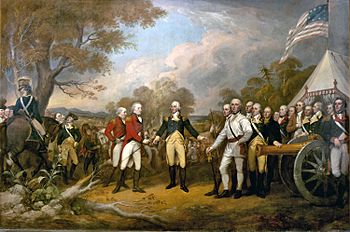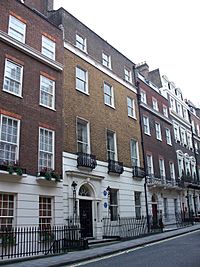John Burgoyne facts for kids
Quick facts for kids
John Burgoyne
|
|
|---|---|

Portrait by Joshua Reynolds, c. 1766
|
|
| Nickname(s) | Gentleman Johnny |
| Born | 24 February 1722 Sutton, Bedfordshire, Great Britain |
| Died | 4 August 1792 (aged 70) Mayfair, London, Great Britain |
| Buried | |
| Allegiance | Great Britain |
| Service/ |
British Army |
| Years of service | 1743–1784 |
| Rank | General |
| Commands held | Commander-in-Chief, Ireland |
| Battles/wars | |
| Awards | Privy Council of Great Britain |
| Other work | Member of the House of Commons of Parliament |
| Signature | |
General John Burgoyne (born February 24, 1722 – died August 4, 1792) was a British general, a writer of plays, and a politician. He was a member of the House of Commons from 1761 to 1792. He first fought in the Seven Years' War, especially during the Portugal Campaign in 1762.
Burgoyne is most famous for his part in the American Revolutionary War. He planned an attack from Canada to separate New England from the other American colonies. He hoped this would end the rebellion. Burgoyne's army moved slowly, which gave the Americans time to gather their forces. The British army in New York City did not help him. Instead, they moved south to capture Philadelphia.
Burgoyne fought two small battles near Saratoga. But American forces surrounded him. With no help coming, he surrendered his entire army of 6,200 men on October 17, 1777. This surrender was a major turning point in the war. It helped the Americans get help from other countries, especially France. France had already been sending supplies to the American colonists since 1776.
Burgoyne and his officers went back to England. His soldiers became prisoners of war. He faced a lot of criticism in London and never led an army again.
Burgoyne was also a talented playwright. He wrote popular plays like The Maid of the Oaks and The Heiress. He served as a member of Parliament for many years.
Contents
Early Life and Army Career
Family and Early Years
John Burgoyne was born in Sutton, Bedfordshire, on February 24, 1722. His father was Captain John Burgoyne, an army officer. His mother was Anna Maria. Some people believed he was the son of Lord Bingley, who was his godfather. When Lord Bingley died, his will said Burgoyne would inherit his property if his daughters had no sons.
From age 10, Burgoyne went to the famous Westminster School. Many British army officers, like Thomas Gage, also went there. Burgoyne was active and friendly. He made important friends, especially Lord James Strange.
In 1737, Burgoyne bought a position in the Horse Guards Regiment, a fancy cavalry group. He was stationed in London and had light duties. This allowed him to be part of high society. He became known as "Gentleman Johnny" because of his stylish uniforms and expensive lifestyle. He spent a lot of money and got into debt. In 1741, he sold his army position, possibly to pay off these debts.
The War of the Austrian Succession started, and the British Army grew. In 1745, Burgoyne joined the new 1st Royal Dragoons as a cornet. He didn't have to pay for this new position. He was promoted to lieutenant in April 1745. In 1747, he managed to buy a captaincy. When the war ended in 1748, there were no more chances for him to serve in active battles.
Marriage and Travel
Through his friend Lord Strange, Burgoyne met Strange's sister, Lady Charlotte Stanley. Her father, Lord Derby, was a very important politician. Lord Derby did not want Burgoyne to marry Charlotte. So, in April 1751, they ran away and got married without his permission. Lord Derby was very angry and didn't give his daughter any money. Burgoyne had to sell his army position again to get money for them to live on. He raised £2,600.
In October 1751, Burgoyne and his wife moved to Europe. They traveled through France and Italy. In France, Burgoyne became friends with the Duc de Choiseul. This man later became the Foreign Minister and guided French policy during the Seven Years War. In Rome, Burgoyne had his portrait painted by the artist Allan Ramsay. In late 1754, his wife gave birth to their only child, Charlotte Elizabeth. The Burgoynes hoped a granddaughter would make Lord Derby less angry. They returned to Britain in 1755. Lord Strange helped them, and Lord Derby soon accepted them back into the family. Burgoyne became a favorite of Lord Derby, who used his influence to help Burgoyne's career.
Seven Years' War Service
A month after the Seven Years' War began, Burgoyne bought a position in the 11th Dragoons. In 1758, he became a captain and lieutenant-colonel in the Coldstream Guards.
Raids and New Cavalry
In 1758, he took part in several attacks on the French coast. During this time, he helped create a new type of soldier for the British Army: light cavalry. These new regiments were led by George Augustus Eliott and Burgoyne. This was a big change. Burgoyne was a leader in developing this new British light cavalry. He liked soldiers who could think for themselves. He encouraged his men to use their own ideas, which was very different from how the British army usually worked.
Success in Portugal
In 1761, he became a member of Parliament for Midhurst. The next year, he served as a brigadier-general in Portugal. Portugal had just joined the war. Burgoyne became famous for leading his cavalry to capture Valencia de Alcántara and Vila Velha de Ródão. This helped make up for the Portuguese loss of Almeida. His actions were very important in stopping a large Spanish army from invading Portugal.
In 1768, he was elected to the House of Commons for Preston. For the next few years, he focused on his duties in Parliament. He was known for speaking his mind. He especially criticized Lord Clive, who was considered a leading soldier at the time. In 1772, Burgoyne gained attention by asking for an investigation into the East India Company. He said there was a lot of unfairness by its officials. At the same time, he spent a lot of time on art and plays. His first play, The Maid of the Oaks, was performed in 1775.
American War of Independence
Early Battles
In the army, he had been promoted to major-general. When the American Revolutionary War began, he was given a command. He arrived in Boston in May 1775, a few weeks after the first shots of the war. He was part of the British forces during the Siege of Boston. He did not fight in the Battle of Bunker Hill. In that battle, the British forces were led by William Howe and Henry Clinton. Burgoyne was frustrated by the lack of action. He returned to England before the rest of the British forces left Boston in March 1776.
In 1776, he led British reinforcements up the Saint Lawrence River. They helped free Quebec City, which was being attacked by the Continental Army. He led forces under General Guy Carleton to chase the Continental Army out of the province of Quebec. Carleton then led the British forces onto Lake Champlain. But Burgoyne thought Carleton was not brave enough when he failed to capture Fort Ticonderoga. This happened after the British won the naval Battle of Valcour Island in October.
The Saratoga Campaign
The next year, Burgoyne convinced King George III that Carleton had made mistakes. So, Burgoyne was given command of the British forces. His job was to take control of Lake Champlain and the Hudson River valley. Burgoyne largely created this plan himself. His idea was for his army to cross Lake Champlain from Quebec. They would capture Ticonderoga and then move on to Albany, New York. There, they would meet another British army coming north from New York City, led by General Howe. A smaller force would also come down the Mohawk River valley. This plan aimed to cut off New England from the southern colonies. The British believed this would make it easier to end the rebellion.
From the start, Burgoyne was very confident. He believed his army was so strong that the campaign would be easy. He thought he would become a national hero for saving the colonies for Britain. Before leaving London, he even bet Charles James Fox 10 pounds that he would return victorious within a year. He ignored warnings from both British and American people. They said a successful campaign using his route was impossible. The failed attempt the year before had shown this.
The plan relied on Burgoyne's attack being supported by two other large British forces. These were led by Generals Howe and Clinton. However, the orders from London were not clear. As a result, Howe did not support Burgoyne. Clinton moved from New York too late and with too few soldiers to help Burgoyne much.
Because of this misunderstanding, Burgoyne had to fight the campaign alone. He didn't know he wouldn't get extra support. He was still quite sure he would win. He had an army of over 7,000 soldiers in Quebec. Burgoyne also believed reports that many Native Americans and American Loyalists would join him once the British moved south. Even if the countryside wasn't as pro-British as expected, much of the area was empty. Burgoyne doubted any large enemy force could gather there.
The campaign started well. Burgoyne captured the important forts of Ticonderoga and Fort Edward. For this, he was made a lieutenant general. But as he pushed on, he decided to cut off his communication with Quebec. He was eventually surrounded by a larger American force led by Major General Horatio Gates. Several attempts to break through the enemy lines failed at Saratoga in September and October 1777. Benedict Arnold played a big part in those battles. Burgoyne's assistant, Sir Francis Clerke, was killed on October 15.
On October 17, 1777, Burgoyne surrendered his entire army of 5,800 men. This was the biggest victory for the American forces in the Revolutionary War so far. It became the turning point in the war, as France then formed an alliance with the American Patriots.
The Convention Army
Instead of a complete unconditional surrender, Burgoyne agreed to a special agreement. His men would give up their weapons and return to Europe. They promised not to fight in North America again. Burgoyne insisted on this point. He even said he would try to fight his way back to Quebec if it wasn't agreed to. Soon after, the Continental Congress went back on this agreement. They imprisoned the remaining soldiers in Massachusetts and Virginia. The prisoners were sometimes treated badly. Many saw this as revenge for the poor treatment of American prisoners of war.
After Saratoga, people in Britain were very angry with Burgoyne. He returned right away, with permission from the American general. He wanted to explain his actions and asked for a trial, but he never got one. He lost his army position and the governorship of Fort William in Scotland, which he had held since 1769. After this defeat, France recognized the United States and joined the war on February 6, 1778. This made the war a global conflict.
At the time, many blamed Burgoyne for the defeat. However, over the years, historians have shifted the blame for the Saratoga disaster to Lord Germain. Germain was in charge of the overall plan for the campaign. He failed to clearly order General Howe to support Burgoyne's invasion. Instead, he let Howe believe he was free to attack Philadelphia.
Later Life and Plays
Before Saratoga, Burgoyne had supported the government. But after returning, he joined a different political group. In 1782, when his political friends came into power, Burgoyne got his rank back. He was made commander-in-chief in Ireland and became a privy councillor. After the government changed again in 1783, Burgoyne spent more time in private life. His last public duty was helping with the trial of Warren Hastings. He died suddenly on August 4, 1792, at his home in Mayfair. He had been seen at the theater the night before and seemed healthy. Burgoyne is buried in Westminster Abbey.
After his wife died in 1776, Burgoyne had four children with Susan Caulfield. One of his sons was Field Marshal John Fox Burgoyne.
As a Playwright
In his time, Burgoyne was a well-known playwright. He wrote several popular plays. The most famous were The Maid of the Oaks (1774) and The Heiress (1786). He helped Richard Brinsley Sheridan with his play The Camp, and may have even helped write it. He also wrote the words for William Jackson's only successful opera, The Lord of the Manor (1780). He also wrote a translated version of a French play called Richard Coeur de lion. This play had music by Thomas Linley the elder and was very popular in 1788. If it weren't for his role in the American War of Independence, Burgoyne would probably be remembered most today as a writer of plays.
Works by Burgoyne
- The Dramatic and Poetical Works of the Late Lieut. Gen. J. Burgoyne, London 1808.
- The Maid of the Oaks (1774, performed with music by François Barthélemon)
- The Camp (1778)
- The Lord of the Manor (1780)
- The Heiress (1786)
- Richard Coeur de Lion (1786)
- He is also said to have written the words to Dashing White Sergeant.
Legacy and Portrayals
Historians often describe Burgoyne as a British general who got his rank through political connections, not just skill. However, soldiers who served under him, like Corporal Roger Lamb, said that Burgoyne "avoided no danger; his presence and conduct encouraged the troops (for they greatly loved their general)."
Burgoyne's fancy lifestyle during the Saratoga campaign, along with his polite manners and playwriting career, led some people to make fun of him. The historian George Billias wrote that he was seen as "a funny person in uniform who messed up his assignments badly." Much of what we know about him comes from these descriptions. Billias thought Burgoyne was a tough and brave general who understood his opponents well. He was also a thoughtful person who commented on society and politics.
Burgoyne has appeared as a character in historical books and stories that imagine different outcomes. He is a character in George Bernard Shaw's play The Devil's Disciple. He was played by Laurence Olivier and Ian Richardson in the film versions. Historical novels by Chris Humphreys about the Saratoga campaign also feature him. Different versions of his campaign appear in For Want of a Nail by Robert Sobel and a 1975 radio play called Windandingo.
Images for kids
See also
 In Spanish: John Burgoyne para niños
In Spanish: John Burgoyne para niños






